"The light that burns twice as bright burns for half as long - and you have burned so very, very brightly, Roy. Look at you: you're the Prodigal Son; you're quite a prize!" -Tyrell, from Blade Runner
Look up at the night sky. On a clear, dark night with normal vision, you can literally see thousands of stars.

Some of them are barely visible, others shine so brightly that they come out when the sky's still blue! Why do some appear brighter than others? Two reasons. Some stars are simply closer to us, but others, intrinsically, shine spectacularly bright. Let's take a look at a small section of the Southern sky.
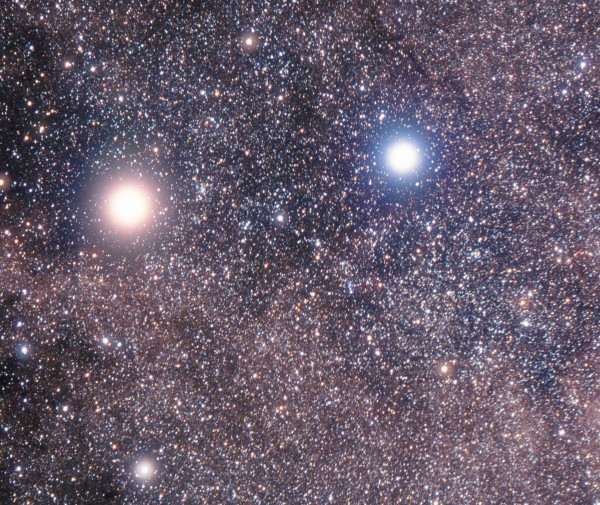
Alpha Centauri (in yellow, above) is one of the brightest stars in the night sky, coming in at #4 on the list. It's similar to our Sun, only a little bit bigger and brighter, and has roughly the same color. The reason it's so bright, though, is that it's so incredibly close to us: only 4.4 light years distant.
But take a look at the second brightest star above (the blue one). Known as Beta Centauri, it's the 10th brightest star in the night sky, appearing about 70% as bright as its yellow neighbor. Except Beta Centauri isn't really Alpha Centauri's neighbor. While that yellow star is 4.4 light years away, Beta Centauri, the blue one, is 530 light years away, or over 100 times as far away!
Why then, does Beta Centauri appear almost as bright as Alpha Centauri?

Well, because it's a different type of star! If we go by color, yellow Alpha Centauri is a "G-type" star, much like our Sun. But Beta Centauri is one of the bluest stars out there, making it a "B-type" star. In fact, if it were just a little bluer, it'd be an "O-type" star, the bluest of them all.
Surprisingly, we can learn a lot from a star's color. For the whole time a star burns Hydrogen into Helium -- just like our Sun has been doing since its birth billions of years ago -- its color is indicative of another property. Take a look at the picture below.
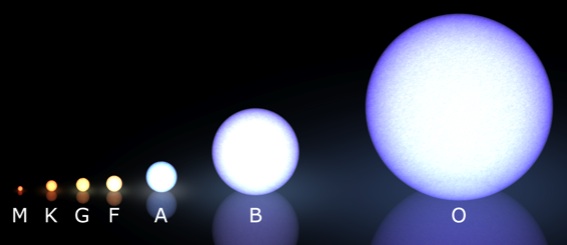
The bluer ones are bigger, too. In fact, the bluer a star is, the larger, brighter, and hotter it is as well! And Tyrell from Blade Runner got it right: the brighter, hotter, bluer stars burn through their fuel faster!
A "G-star" like our Sun will live about 10 billion years. A star only 10% as massive, an "M-star", will live many trillions of years! But what if you start looking at stars more massive than our Sun? Well, you need to know where to look, because the very massive ones are rare. We find most of them inside star clusters, like 30 Doradus, below.
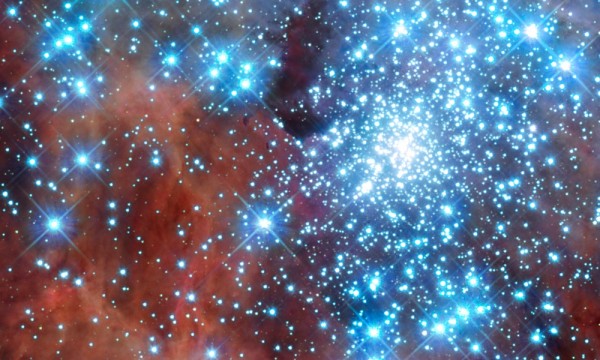
A "B-type" star, like Beta Centauri, can be up to about 12 times as massive as our Sun, and instead of 10 billion years, only lasts about 10-20 million years before it burns out all of its fuel. Despite being over 100 times farther away and having much more fuel to burn, a B-type star can appear incredibly bright and short-lived, because it burns its fuel over 10,000 times faster than the Sun does!
But they're not even the most extreme stars in the Universe. If you can get more than around 12-15 times the mass of the Sun together in one star, you're going to get the brightest, hottest star type in the whole Universe, an "O-type" star, like Alnitak (below).
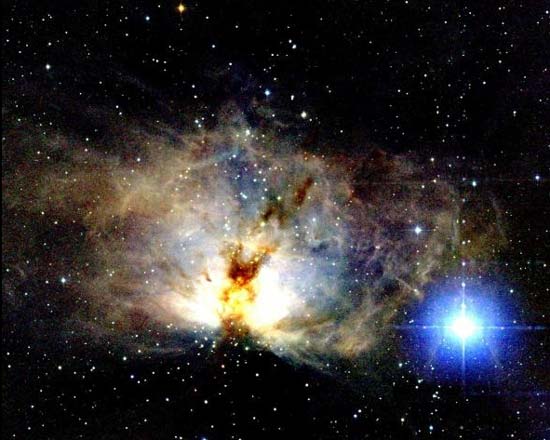
But why muck around with a star only 28 times as massive as our Sun? Even though Alnitak has a total lifetime of just one or two million years or so, we can find even brighter, heavier, shorter-lived ones. If we look near the center of the galaxy, we can find star WR 102ka, located in the Peony Nebula below.
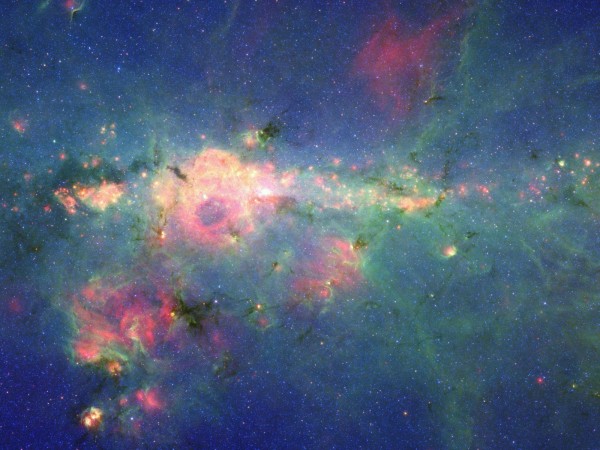
WR 102ka is located where the bright white spot near the center of the image is, and it weighs in at a whopping 175 times the mass of the Sun! At around 25,000 light years away, WR 102ka has an incredibly interesting property: it's already dead! A star that massive will live less than 25,000 years, and since the light we're seeing now left that star 25,000 years ago, it's already burned up all of its fuel, and has likely died in a tremendous supernova explosion!
But WR 102ka, you need to move your skinny butt over. There's a new star in town that's got you beat.

(And click to enlarge this image above.)
Deep inside the Large Magellanic Cloud, 160,000 light years away, the star R136a1 has just shattered all of the records.
It weighs in at 265 times the mass of the Sun. It's so massive that it's probably already blown off something like 60 times the mass of the Sun, meaning it was over 300 times as massive as the Sun when it was born. A star like this is unheard of, and many were dubious that a star like this could have even existed! With a lifetime under 10,000 years, we're lucky to have caught a glimpse of it at all!
And since it is the biggest star we've ever found, would you like to see an illustration of just how big it is?
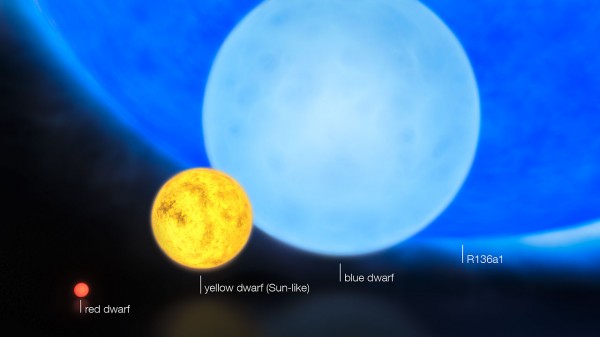
In terms of size, this star is to the Sun like Jupiter is to the Earth: huge!
In terms of energy output, this one star, R136a1, radiates more than 10 million times faster than our Sun. Imagine that, for a minute. If you replaced the Sun with this star, you'd be able to place Earth nearly an entire light-year away from the Sun, and life would still survive. For comparison, in our solar system, it takes sunlight less than nine minutes to reach us.
So be aware that behemoths like this are out there, burning through Hydrogen with the fury of millions of Suns, and be very, very happy about the fact that they're as far away from us as they are!
- Log in to post comments

Ethan,
First, cool!
Second, in your third image above, in addition to the M through O type stars illustrated next there are also two objects labeled T & L. What are they? Thanks!
Well, WR 102ka may be the most massive, and the brightest, but it is far from the biggest. The red Hyper-giant star "Canis Majoris" is waaaay bigger. google it, and see size comparison with the sun.
How do we know R136a isn't a binary of two extremely large, but not model-destroying, stars? I seem to recall that this was an issue for several other hot blue supergiants.
"and be very, very happy about the fact that they're as far away from us as they are!"
we wouldn't be here to be very happy if it wasn't a fact =p
i bet you are tired if this kind of thinking =p
and thx for this... enlightening post
Aha. This may answer a question I've been wondering about. Since heavier elements (and in particular, Carbon) need to be generated in stars, and then scattered about to be later accumulated on cold wet things like Class M planets, there was no chance of life forming on any planet like body circling any early stars (because they couldn't have existed) or later in time (because there could not have been much carbon). So if the universe is 14*10^9 years old and a "typical" star cycles at 5*10^9 or whatever, sufficient carbon to be laying around for life to get started would have existed only in the more recent cycles, easily for the last half of the Universe's time, not so likely for the first half.
But if there are these big huge stars that cycle quickly, no problem. Lots of carbon and other elements would be around early on.
Right? Wrong? Not so simple?
@ Lane: the normal stellar classification system runs O, B, A, F, G, K, M, however there are a few extensions: at the very bright end, Wolf-Rayet stars (types W, or ON, OC, BN, BC) have mostly helium burning rather than hydrogen and often exhibit strong emission lines of nitrogen, carbon, or oxygen. At the cool end, L and T are red and brown dwarfs respectively, the brown dwarfs having their peak emission in the infra-red and displaying methane in their spectra.
@ Greg: supernova explosions are usually viewed as the prime mechanism for distributing large quantities of higher mass nuclides around a galaxy (especially trans-ferrous elements) since the supergiant stars involved usually have very short life-times, but have nonetheless run all the way up to the iron limit, and the explosions blow off a considerable proportion of the mass in a shockwave expanding in all directions. So initially heavy elements are confined to regions that are proximate to supernova eruptions, but over a long period of time they would tend to be better scattered throughout a galaxy.
I have to wonder here..
If the lifetime of this thing is only 10,000 years, does it ever really qualify as a star in the sense that most people would recognise? After all, surely it will still be in the process of coalescing when it goes supernova?
Henjak (#2): You probably mean "VY Canis Majoris".
See, this proves there's a creator! So as the sun starts to set on Saturday, October 22, 4004 BC, God starts work and says to his little boy, "Stick with me, kid, and I'll make you a big star...."
Andrew @7: If it has intrinsic luminosity due to continuous fusion reactions, it's a star. You are probably right that it never settles down to an equilibrium size, which is part of the reason it has blown off so much mass. Also, the t=0 point for a star comes after (or near the end of) the coalescence phase, since you have to have compressed a core to the necessary region of temperature-pressure space to ignite fusion.
I think I read that when stars start fusing, the outward radiation pressure prevents the star collecting more hydrogen. So, what are the top theories for how a star gets this big? Colliding stars?
Haven't you got your massive stellar lifetimes a bit off. I read that these heavyweights last a million or two years. If I do a simple computation L/M (luminosity divided by mass) for R136a1 versus the sun the number is 30e3, leading to an expected lifetime of 300,000 years. If I then account for the fact that the variation of luminosity of a solar type star is maybe 10,000 time (red giant versus main sequence), but O type stars luminosity doesn't vary so much I'd think the heavyweight lifetime would be lengthened more. Then the heavyweights burn more of their fuel during their lifetime (I'm not sure this is true, perhaps the core explodes too early to allow this), the heavyweights gain another advantage. So I suspect the press reported lifetimes of a million or two million years is closer to the truth.
@Greg Laden:
you pretty much summed it up.
however, i recently read something someplace (nature? science? boys life?)that suggested supernovas can't account for all the metals* in the universe.
*apparently wacky astro types consider everything but hydrogen and helium a metal.
It seems to me that the numbers in this article must be inaccurate. If the power output of a star is 10 million times that of the sun, the the distance at which we would receive the same power flux is about 3162 times the distance to the sun (3162 is square root of 10 million). The sun is about 8.3 light minutes from the earth. Hence to get the same radiation from the big star, the distance should be about 18.3 light days which is way short of the claimed "nearly a light year" (still an impressive distance though).
If nothing (by Einsteinian theory, anyhow) can travel faster than light, and if time and space are interconvertible, how can one say that a what we are seeing is the light of a star that "used to be?"
@Steve nobody said that. It's perfectly possible (and likely in the case of a large or distant star) that the stars we're observing now have long since died.
Bah, never mind, I totally misread that comment.
Scientists are not really sure about the brightest stars because we have studied just a bit
But if we still get the light, gravity and so on of a star, in what sense is it not there?
hi i was on the net looking at the cosmos when i forgot the full name of the biggest star ever found so far. then...while looking for the name i found your article.
two questions...1 is R136a1 and vy Canis Majoris the same star?...because i thought vy Canis was the biggest followed by beetle juice second.
and 2 you mentioned that the biggest stars burn blue^^...so then why dose Canis Majoris burn red in every demonstration that I've seen of it?. thnx...and a friendly reminder that am just a novice.
VY Canis Majoris is not fesable it is that big our sun is a like the size of an atom compared it google search it and u will know wat i mean.
too many words!
unde este invatatura?
care sunt stelele mari?
where are the big stars?
I like!
where are the planets?
is r136a1 more powerful than vy canis majoris?
is vy canis majoris is bigger than r136a1??
when it vy canis majoris and r136a1,which one is more bigger blast scientist ??
is VY CANIS MAJORIs IS THE BIGGEST STAR IN THE UNIVERES
Does nobody know how big planets around that big star could be?
The bigger the star the bigger the planets in those systems are.
That would make planets bigger then our own sun...... we only cant see them because of the star itself....
Does not follow.
The star could have gobbled up all the material leaving nothing for planets to form with.
A planet bigger than the sun would be a star.
is there a biggest stars doesnt discover yet?
i can"t realize there have a biggest star.
What would it take to move planet to the right atmosphere temperature from the sun
To hold life
?
What about vy canis majoris?
@Arfat #36: See the Wikipedia article (http://en.wikipedia.org/wiki/VY_Canis_Majoris). It is only 17 solar masses (compared to 265 M_sun for R136a1 discussed here), and has a radius of 1420 R_sun, compared to just 35 R_sun for R136a1. So VY CMa is bigger in volume, but much, much smaller in mass.
Why are the star look different shape from the stars look if you seen the R136a1 that is not a star ship it looks circle!!!
The energy a planet receives from a star diminishes with the square of the distance from that star. If the star puts out 10 million times as much energy as the Sun, then for a planet to receive the same amount of energy as Earth, it should be 1 AU x sqrt(10,000,000) distance from the star. That's about 20 light-days, not 1 light-year. Am I missing something?
@38 ian
the graphic is an artists impression of the differing sizes of those stars. In the photographs of real stars, the cross you see from the brighter stars is caused by the mechanical structure of the telescope. Stars do not naturally have anything other than a spherical shape. Hope that helps a little. :)
Wonderful !